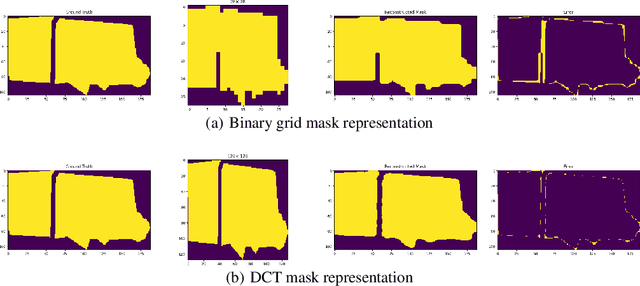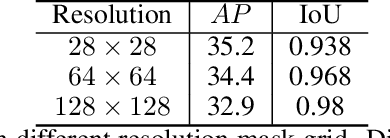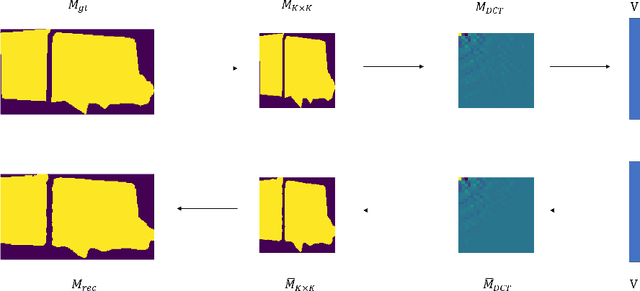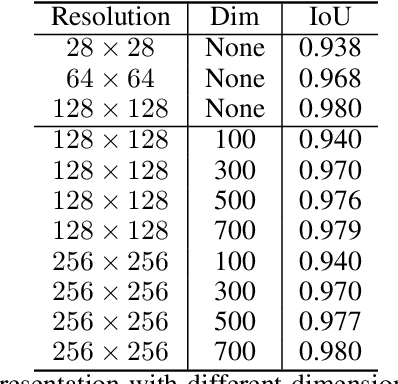Bing Deng
Grounding 3D Object Affordance with Language Instructions, Visual Observations and Interactions
Apr 07, 2025Abstract:Grounding 3D object affordance is a task that locates objects in 3D space where they can be manipulated, which links perception and action for embodied intelligence. For example, for an intelligent robot, it is necessary to accurately ground the affordance of an object and grasp it according to human instructions. In this paper, we introduce a novel task that grounds 3D object affordance based on language instructions, visual observations and interactions, which is inspired by cognitive science. We collect an Affordance Grounding dataset with Points, Images and Language instructions (AGPIL) to support the proposed task. In the 3D physical world, due to observation orientation, object rotation, or spatial occlusion, we can only get a partial observation of the object. So this dataset includes affordance estimations of objects from full-view, partial-view, and rotation-view perspectives. To accomplish this task, we propose LMAffordance3D, the first multi-modal, language-guided 3D affordance grounding network, which applies a vision-language model to fuse 2D and 3D spatial features with semantic features. Comprehensive experiments on AGPIL demonstrate the effectiveness and superiority of our method on this task, even in unseen experimental settings. Our project is available at https://sites.google.com/view/lmaffordance3d.
Efficient Alignment of Unconditioned Action Prior for Language-conditioned Pick and Place in Clutter
Mar 12, 2025Abstract:We study the task of language-conditioned pick and place in clutter, where a robot should grasp a target object in open clutter and move it to a specified place. Some approaches learn end-to-end policies with features from vision foundation models, requiring large datasets. Others combine foundation models in a zero-shot setting, suffering from cascading errors. In addition, they primarily leverage vision and language foundation models, focusing less on action priors. In this paper, we aim to develop an effective policy by integrating foundation priors from vision, language, and action. We propose A$^2$, an action prior alignment method that aligns unconditioned action priors with 3D vision-language priors by learning one attention layer. The alignment formulation enables our policy to train with less data and preserve zero-shot generalization capabilities. We show that a shared policy for both pick and place actions enhances the performance for each task, and introduce a policy adaptation scheme to accommodate the multi-modal nature of actions. Extensive experiments in simulation and the real-world show that our policy achieves higher task success rates with fewer steps for both pick and place tasks in clutter, effectively generalizing to unseen objects and language instructions.
PerlDiff: Controllable Street View Synthesis Using Perspective-Layout Diffusion Models
Jul 08, 2024



Abstract:Controllable generation is considered a potentially vital approach to address the challenge of annotating 3D data, and the precision of such controllable generation becomes particularly imperative in the context of data production for autonomous driving. Existing methods focus on the integration of diverse generative information into controlling inputs, utilizing frameworks such as GLIGEN or ControlNet, to produce commendable outcomes in controllable generation. However, such approaches intrinsically restrict generation performance to the learning capacities of predefined network architectures. In this paper, we explore the integration of controlling information and introduce PerlDiff (Perspective-Layout Diffusion Models), a method for effective street view image generation that fully leverages perspective 3D geometric information. Our PerlDiff employs 3D geometric priors to guide the generation of street view images with precise object-level control within the network learning process, resulting in a more robust and controllable output. Moreover, it demonstrates superior controllability compared to alternative layout control methods. Empirical results justify that our PerlDiff markedly enhances the precision of generation on the NuScenes and KITTI datasets. Our codes and models are publicly available at https://github.com/LabShuHangGU/PerlDiff.
CT3D++: Improving 3D Object Detection with Keypoint-induced Channel-wise Transformer
Jun 12, 2024



Abstract:The field of 3D object detection from point clouds is rapidly advancing in computer vision, aiming to accurately and efficiently detect and localize objects in three-dimensional space. Current 3D detectors commonly fall short in terms of flexibility and scalability, with ample room for advancements in performance. In this paper, our objective is to address these limitations by introducing two frameworks for 3D object detection with minimal hand-crafted design. Firstly, we propose CT3D, which sequentially performs raw-point-based embedding, a standard Transformer encoder, and a channel-wise decoder for point features within each proposal. Secondly, we present an enhanced network called CT3D++, which incorporates geometric and semantic fusion-based embedding to extract more valuable and comprehensive proposal-aware information. Additionally, CT3D ++ utilizes a point-to-key bidirectional encoder for more efficient feature encoding with reduced computational cost. By replacing the corresponding components of CT3D with these novel modules, CT3D++ achieves state-of-the-art performance on both the KITTI dataset and the large-scale Way\-mo Open Dataset. The source code for our frameworks will be made accessible at https://github.com/hlsheng1/CT3D-plusplus.
RoScenes: A Large-scale Multi-view 3D Dataset for Roadside Perception
May 17, 2024



Abstract:We introduce RoScenes, the largest multi-view roadside perception dataset, which aims to shed light on the development of vision-centric Bird's Eye View (BEV) approaches for more challenging traffic scenes. The highlights of RoScenes include significantly large perception area, full scene coverage and crowded traffic. More specifically, our dataset achieves surprising 21.13M 3D annotations within 64,000 $m^2$. To relieve the expensive costs of roadside 3D labeling, we present a novel BEV-to-3D joint annotation pipeline to efficiently collect such a large volume of data. After that, we organize a comprehensive study for current BEV methods on RoScenes in terms of effectiveness and efficiency. Tested methods suffer from the vast perception area and variation of sensor layout across scenes, resulting in performance levels falling below expectations. To this end, we propose RoBEV that incorporates feature-guided position embedding for effective 2D-3D feature assignment. With its help, our method outperforms state-of-the-art by a large margin without extra computational overhead on validation set. Our dataset and devkit will be made available at https://github.com/xiaosu-zhu/RoScenes.
Rethinking IoU-based Optimization for Single-stage 3D Object Detection
Jul 20, 2022



Abstract:Since Intersection-over-Union (IoU) based optimization maintains the consistency of the final IoU prediction metric and losses, it has been widely used in both regression and classification branches of single-stage 2D object detectors. Recently, several 3D object detection methods adopt IoU-based optimization and directly replace the 2D IoU with 3D IoU. However, such a direct computation in 3D is very costly due to the complex implementation and inefficient backward operations. Moreover, 3D IoU-based optimization is sub-optimal as it is sensitive to rotation and thus can cause training instability and detection performance deterioration. In this paper, we propose a novel Rotation-Decoupled IoU (RDIoU) method that can mitigate the rotation-sensitivity issue, and produce more efficient optimization objectives compared with 3D IoU during the training stage. Specifically, our RDIoU simplifies the complex interactions of regression parameters by decoupling the rotation variable as an independent term, yet preserving the geometry of 3D IoU. By incorporating RDIoU into both the regression and classification branches, the network is encouraged to learn more precise bounding boxes and concurrently overcome the misalignment issue between classification and regression. Extensive experiments on the benchmark KITTI and Waymo Open Dataset validate that our RDIoU method can bring substantial improvement for the single-stage 3D object detection.
Improving 3D Object Detection with Channel-wise Transformer
Aug 23, 2021



Abstract:Though 3D object detection from point clouds has achieved rapid progress in recent years, the lack of flexible and high-performance proposal refinement remains a great hurdle for existing state-of-the-art two-stage detectors. Previous works on refining 3D proposals have relied on human-designed components such as keypoints sampling, set abstraction and multi-scale feature fusion to produce powerful 3D object representations. Such methods, however, have limited ability to capture rich contextual dependencies among points. In this paper, we leverage the high-quality region proposal network and a Channel-wise Transformer architecture to constitute our two-stage 3D object detection framework (CT3D) with minimal hand-crafted design. The proposed CT3D simultaneously performs proposal-aware embedding and channel-wise context aggregation for the point features within each proposal. Specifically, CT3D uses proposal's keypoints for spatial contextual modelling and learns attention propagation in the encoding module, mapping the proposal to point embeddings. Next, a new channel-wise decoding module enriches the query-key interaction via channel-wise re-weighting to effectively merge multi-level contexts, which contributes to more accurate object predictions. Extensive experiments demonstrate that our CT3D method has superior performance and excellent scalability. Remarkably, CT3D achieves the AP of 81.77% in the moderate car category on the KITTI test 3D detection benchmark, outperforms state-of-the-art 3D detectors.
Revisiting Knowledge Distillation: An Inheritance and Exploration Framework
Jul 01, 2021



Abstract:Knowledge Distillation (KD) is a popular technique to transfer knowledge from a teacher model or ensemble to a student model. Its success is generally attributed to the privileged information on similarities/consistency between the class distributions or intermediate feature representations of the teacher model and the student model. However, directly pushing the student model to mimic the probabilities/features of the teacher model to a large extent limits the student model in learning undiscovered knowledge/features. In this paper, we propose a novel inheritance and exploration knowledge distillation framework (IE-KD), in which a student model is split into two parts - inheritance and exploration. The inheritance part is learned with a similarity loss to transfer the existing learned knowledge from the teacher model to the student model, while the exploration part is encouraged to learn representations different from the inherited ones with a dis-similarity loss. Our IE-KD framework is generic and can be easily combined with existing distillation or mutual learning methods for training deep neural networks. Extensive experiments demonstrate that these two parts can jointly push the student model to learn more diversified and effective representations, and our IE-KD can be a general technique to improve the student network to achieve SOTA performance. Furthermore, by applying our IE-KD to the training of two networks, the performance of both can be improved w.r.t. deep mutual learning. The code and models of IE-KD will be make publicly available at https://github.com/yellowtownhz/IE-KD.
The Blessings of Unlabeled Background in Untrimmed Videos
Mar 31, 2021



Abstract:Weakly-supervised Temporal Action Localization (WTAL) aims to detect the action segments with only video-level action labels in training. The key challenge is how to distinguish the action of interest segments from the background, which is unlabelled even on the video-level. While previous works treat the background as "curses", we consider it as "blessings". Specifically, we first use causal analysis to point out that the common localization errors are due to the unobserved confounder that resides ubiquitously in visual recognition. Then, we propose a Temporal Smoothing PCA-based (TS-PCA) deconfounder, which exploits the unlabelled background to model an observed substitute for the unobserved confounder, to remove the confounding effect. Note that the proposed deconfounder is model-agnostic and non-intrusive, and hence can be applied in any WTAL method without model re-designs. Through extensive experiments on four state-of-the-art WTAL methods, we show that the deconfounder can improve all of them on the public datasets: THUMOS-14 and ActivityNet-1.3.
DCT-Mask: Discrete Cosine Transform Mask Representation for Instance Segmentation
Nov 19, 2020



Abstract:Binary grid mask representation is broadly used in instance segmentation. A representative instantiation is Mask R-CNN which predicts masks on a $28\times 28$ binary grid. Generally, a low-resolution grid is not sufficient to capture the details, while a high-resolution grid dramatically increases the training complexity. In this paper, we propose a new mask representation by applying the discrete cosine transform(DCT) to encode the high-resolution binary grid mask into a compact vector. Our method, termed DCT-Mask, could be easily integrated into most pixel-based instance segmentation methods. Without any bells and whistles, DCT-Mask yields significant gains on different frameworks, backbones, datasets, and training schedules. It does not require any pre-processing or pre-training, and almost no harm to the running speed. Especially, for higher-quality annotations and more complex backbones, our method has a greater improvement. Moreover, we analyze the performance of our method from the perspective of the quality of mask representation. The main reason why DCT-Mask works well is that it obtains a high-quality mask representation with low complexity. Code will be made available.
 Add to Chrome
Add to Chrome Add to Firefox
Add to Firefox Add to Edge
Add to Edge